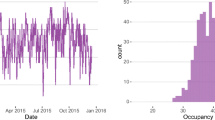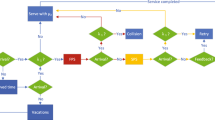Abstract
Long Range Dependent (LRD) network traffic does not behave like the traffic generated by the Poisson model or other Markovian models. From the network performance point of view, the main difference is that LRD traffic increases queueing delays due to its burstiness over many time scales. LRD behavior has been observed in different types and sizes of networks, for different applications (e.g., WWW) and different traffic aggregations. Since LRD behaviour is not rare nor isolated, accurate characterization of LRD traffic is very important in order to predict performance and to allocate network resources. The Hurst parameter is commonly used to quantify the degree of LRD and the burstiness of the traffic. In this paper we investigate the validity and effectiveness of the Hurst parameter. To this end, we analyze the UCLA Computer Science Department network traffic traces and compute their Hurst parameters. Queueing simulation is used to study the impact of LRD and to determine if the Hurst parameter accurately describes such LRD. Our results show that the Hurst parameter is not by itself an accurate predictor of the queueing performance for a given LRD traffic trace.
Similar content being viewed by others
References
P. Abry and D. Veitch, Wavelet analysis of long range dependent traffic, Transactions on Information Theory 44(1) (1998) 2-15.
R.G. Addie, M. Zukerman and T. Neame, Performance of a single server queue with self-similar input, in: IEEE INFOCOM'95, Seattle, 1995.
J. Beran, R. Sherman, M.S. Taqqu and W. Willinger, Long-range dependence in variable-bit-rate video traffic, IEEE/ACM Transactions on Communications 2(4) (1995) 1566-1579.
M.E. Crovella and A. Bestavros, Explaining World Wide Web traffic self-similarity, Technical Report TR-95-015, Boston University (1995).
M.E. Crovella and A. Bestavros, Self-similarity in World Wide Web traffic evidence and possible causes, in: 1996 ACM SIGMETRICS Internat. Conf. on Measurement, Modeling of Computer System, 1996, pp. 160-169.
D.E. Duffy, A.A. McIntosh, M. Rosenstein and W. Willinger, Statistical analysis of CCSN/SS7 traffic data from working subnetworks, IEEE Journal on Selected Areas in Communications 12(3) (1994) 544-551.
A. Erramilli, O. Narayan and W. Willinger, Experimental queueing analysis with long-range dependent packet traffic, IEEE/ACM Transactions on Networking 4(2) (1996) 209-223.
H.J. Fowler and W.E. Leland, Local area network traffic characteristics, with inplications for broadband network congestion management, IEEE Journal on Selected Areas in Communications 9 (1991) 1139-1149.
J. Gao and I. Rubin, Multifractal modeling of counting processes of long-range dependent network traffic, in: ATS'99, San Diego, 1999.
J. Gao and I. Rubin, Multifractal analysis and modeling of long-range dependent network traffic, in: IEEE ICC'99, Proceedings of the ICC'99, Vancouver, BC, Canada, 1999, pp. 382-386.
V. Jacobson, C. Leres and S. McCanne, The Tcpdump manual page, Lawrence Berkeley Laboratory (1989), http://ee.lbl.gov/,ftp://ftp.ee.lbl.gov/tcpdump.tar.Z.
W.E. Leland, M.S. Taqqu, W. Willinger and D.V. Wilson, On the self-similar nature of Ethernet traffic (extended version), IEEE/ACM Transactions on Networking 2(1) (1994) 1-15.
A.L. Neidhardt and J.L. Wang, The concept of relevant time scales and its application to queueing analysis of self-similar traffic (or is Hurst naughty or nice?), ACM Performance Evaluation Review 26(1) (1998) 222-232.
V. Paxson and S. Floyd, Wide-area traffic: The failure of Poisson modeling, IEEE/ACMTransactions on Networking 3(3) (1995) 226-244.
T.S. Trivedi, Probability and Statistics with Reliability, Queueing, and Computer Science Applications (Prentice-Hall, Englewood Cliffs, NJ, 1982) pp. 543-545.
D. Veitch and P. Abry, A wavelet-based joint estimator of the parameters of long-range dependence, in: GRESTI, Grenoble, 1997, http://universe.serc.rmit.edu.au/darryl/.
W. Willinger et al., Measuring ATM traffic cell-by-cell: Experiences and preliminary findings from BAGNet, in: PMCCN '97, Internat. Conf. on the Performance and Management of Complex Communication, Tsukuba, Japan, 17–21 November 1997.
W. Willinger et al., Self-similarity in high-speed packet traffic: Analysis of modeling of Ethernet traffic measurements, Statistical Science 10(1) (1995) 71-86.
W. Willinger, M.S. Taqqu, M.S. Sherman and D.V. Wilson, Self-similarity through high-variability: Statistical analysis of Ethernet LAN traffic at the source level (extended version), IEEE/ACM Transactions on Networking 5 (1996) 71-86.
Author information
Authors and Affiliations
Rights and permissions
About this article
Cite this article
Ritke, R., Hong, X. & Gerla, M. Contradictory relationship between Hurst parameter and queueing performance (extended version). Telecommunication Systems 16, 159–175 (2001). https://doi.org/10.1023/A:1009063114616
Issue Date:
DOI: https://doi.org/10.1023/A:1009063114616




